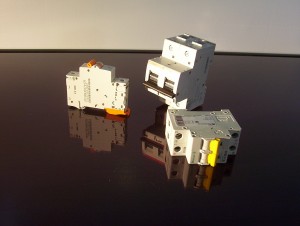Brief Guide to Selecting Breakers and Isolators for Solar PV
This is a short guide to selecting breakers and isolators for grid connected solar PV generation systems using standard panels (i.e. common monocrystalline and polycrystalline types – not Sunpower, Thin Film or CdTe) in a single string configuration – for larger systems with parallel strings consult AS5033 or one of our trained PV design staff
Breakers and DC PV isolators provide methods for us to stop current and voltage being supplied to equipment when we would like to remove or service those items, or in the event of an emergency. For the solar inverter at ground level, there will be two feeds connected to the unit, these being the AC electricity grid (for the inverter’s output) and the DC electricity source (its input from from solar panels). Each of these neesds isolation, and have different requirements. This is a starter guide, and the ultimate decider in terms of what to do is the Australian Standard series AS3000, AS5033 and AS4777 – together with the service rules of your electricity network and the Clean Energy Council guidelines.

![]() Select the AC breaker for the system, making sure that it is a lockable type (has a small hole for a lockout tag), taking into account the output of the inverter now and in the future (its maximum output divided by the grid voltage, in most cases). At the same time, it must be able to protect the cable it is connected to, such that the breaker would trip before damage is done to the cable – select the cable first using the expected current and a wire guage chart. In Australia, it’s also necessary that the normal supply main switch that controls consumption circuits is also a lockable type switch or breaker.
Select the AC breaker for the system, making sure that it is a lockable type (has a small hole for a lockout tag), taking into account the output of the inverter now and in the future (its maximum output divided by the grid voltage, in most cases). At the same time, it must be able to protect the cable it is connected to, such that the breaker would trip before damage is done to the cable – select the cable first using the expected current and a wire guage chart. In Australia, it’s also necessary that the normal supply main switch that controls consumption circuits is also a lockable type switch or breaker.
![]() Examine your inverter specs and confirm whether the inverter is an isolating transformer type, or a non-isolating transformerless inverter. In the absence of a notice from the manufacturer, transformerless inverters will need to be fitted with breakers of a higher voltage range than isolating types.
Examine your inverter specs and confirm whether the inverter is an isolating transformer type, or a non-isolating transformerless inverter. In the absence of a notice from the manufacturer, transformerless inverters will need to be fitted with breakers of a higher voltage range than isolating types.
![]() For transformer isolating inverters you will need a DC breaker or isolator that is double pole (breaks negative and positive simultaneously) and is rated to break 1.25 x the Short Circuit Current (Isc) rating of the solar PV array AND 1.2 x the Open Circuit voltage (Voc) of the array. For transformerless, see ‘4’ below.
For transformer isolating inverters you will need a DC breaker or isolator that is double pole (breaks negative and positive simultaneously) and is rated to break 1.25 x the Short Circuit Current (Isc) rating of the solar PV array AND 1.2 x the Open Circuit voltage (Voc) of the array. For transformerless, see ‘4’ below.
Example 1: Assume the inverter is an SMA Sunnyboy SB1700 isolating transformer type. For a BP Solar 190W panel such as the 4190T, the Voc is 45.3V and Isc is 5.56A. An array of 8 will have a series connected Voc of 8 x 45.3V = 362.4V and Isc of 5.56A -> 1.25 x 5.56 = 6.95A and 1.2 x 362.4 = 434.88V; the closest match would be an ABB 10A 440V DC Circuit Breaker, or a combination of an 8A fuse with a 500V DC isolator (fault protection is not technically required for single strings)
![]() For transformerless non-isolating inverters that do not have a declaration from the manufacturer concerning fault protection, it is not only required that the isolator or breaker be double pole, but also necessary that the isolator can accept the full array voltage across just one pole – so the whole breaker rating needs to be 2 x 1.2 x Array Voc in most cases.
For transformerless non-isolating inverters that do not have a declaration from the manufacturer concerning fault protection, it is not only required that the isolator or breaker be double pole, but also necessary that the isolator can accept the full array voltage across just one pole – so the whole breaker rating needs to be 2 x 1.2 x Array Voc in most cases.
Example 2: Assume the inverter is a non-isolating CMS 2000 or SEA Orion transformerless inverter. For a BP Solar 190W panel such as the 4190T, the Voc is 45.3V and Isc is 5.56A. In an array of 8 panels the solar generation system will have a series connected Voc of 8 x 45.3V = 362.4V and Isc of 5.56A -> 1.25 x 5.56A = 6.95A and 2 x 1.2 x 362.4 = 869.76V; the closest match would be an ABB 10A 1000V DC Circuit Breaker, or a combination of an 1000V rated 8A fuse with a 1000V DC isolator (fault protection is not technically required for single strings).
Generally speaking, breakers and isolators suitable for Solar PV are not available in tight sizes, but rather some common jump points are:
DC Current: 8A, 10A, 16A, 20A, 25A, 32A
DC Voltage: 250V, 440V, 500V, 800V and 1000V
